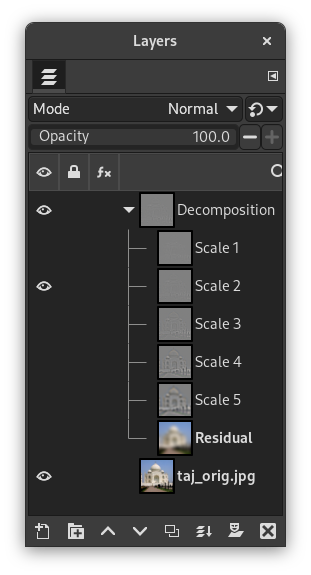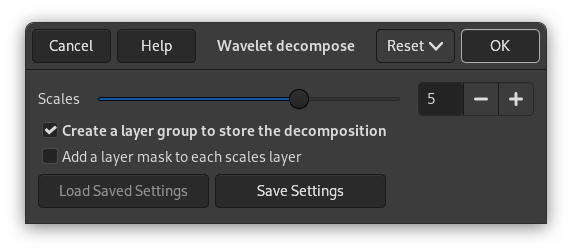![[Nota]](images/note.png)
|
Nota |
|---|---|
|
Le spiegazioni sono in gran parte ispirate dai tutorial di Pat David https://patdavid.net/2011/12/getting-around-in-gimp-skin-retouching.html e https://patdavid.net/2014/07/wavelet-decompose-again.html. |
Figura 17.49. Esempio del filtro «Scomposizione-Wavelet»

Immagine originale

«Scomposizione Wavelet» applicata. Solo scala 2 viene resa visibile nel gruppo livelli.

Questo filtro scompone il livello o la selezione attivi in diversi livelli, chiamati «scale», ognuno di questi contiene un particolare insieme di dettagli. I dettagli più fini sono nei primi livelli e diventano più grandi andando verso l'ultimo, in fondo. Quest'ultimo livello viene chiamato «residuo» e contiene ciò che è rimasto dopo che sono stati rimossi tutti i livelli dei dettagli; esso rappresenta il contrasto e i colori globali dell'immagine.
Ogni livello scala viene impostato per essere combinati tramite la modalità di livello Fondi grana. Ciò significa che i pixel che hanno un valore al 50% non influenzeranno il risultato finale. Perciò, disegnare una scala wavelet con grigio neutro (R:50% V:50% B:50%) cancellerà i dettagli.
Si noti che per le immagini che usano la precisione intera, viene utilizzata la modalità di fusione della grana legacy. Questo evita una ricostruzione imperfetta dell'immagine quando si utilizza la precisione intera. Quando si utilizza la precisione in virgola mobile, viene utilizzata la modalità di fusione della grana standard.
La Scomposizione Wavelet è un meraviglioso filtro per rendere la pelle uniforme e per il suo fotoritocco; rimuove imperfezioni, rughe, e macchie dalle foto. Può anche essere usato per aumentare la nitidezza, per l'aumento localizzato del contrasto e per rimuovere macchie, colori o tonalità. Tutto questo è ben spiegato nei tutorial menzionati in precedenza.
Scala: il numero predefinito è 5. Lo si può aumentare per aumentare la granularità della singola scala.
Crea un gruppo di livelli per memorizzare la scomposizione: i gruppi di livelli sono trattati in Sezione 5, «Gruppi di livelli».
Aggiungi una maschera di livello per ogni livello scalato: le maschere di livello sono trattate in Sezione 2.1.4, «Maschere di livello».




